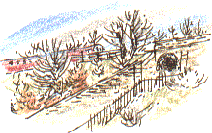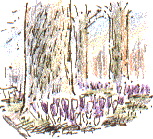Nature Diary
Rocks
History
Gallery
Links
Home Page
 A BIRTHDAY LUNCH for my Mum, at R's in Skopos Mills, Batley; I keep glancing out of the window at this railway embankment, expecting to see something remarkable, but I don't see so much as a crow or a gull the whole time I'm sitting there. I guess that's the drawback to eating and drinking, laughing and talking.
A BIRTHDAY LUNCH for my Mum, at R's in Skopos Mills, Batley; I keep glancing out of the window at this railway embankment, expecting to see something remarkable, but I don't see so much as a crow or a gull the whole time I'm sitting there. I guess that's the drawback to eating and drinking, laughing and talking.
  But, when I go through to the toilets, I start to notice traces of prehistoric life in the tiles of polished limestone on the walls. First I notice the spiral of a snail shell, the size of a small coin. Then, in another panel, a different kind of shell, shaped like a turret. There are very few fossils and I wonder if the stone is Travertine, a kind of limestone that forms in volcanic regions where there are hot springs. Fossils are rare in travertine.
But, when I go through to the toilets, I start to notice traces of prehistoric life in the tiles of polished limestone on the walls. First I notice the spiral of a snail shell, the size of a small coin. Then, in another panel, a different kind of shell, shaped like a turret. There are very few fossils and I wonder if the stone is Travertine, a kind of limestone that forms in volcanic regions where there are hot springs. Fossils are rare in travertine.
 There are cracks that have been filled by with pearly Calcite.
There are cracks that have been filled by with pearly Calcite.
Some of the layers are made up of little fragments of limestone. These layers were likely sorted by currents in water; 
- the largest fragments are deposited first
- as the current ebbs, smaller fragments settle out
- eventually, in still water, fine mud is deposited
- as water floods in again and then again, layer after layer builds up.
This normal state of affairs in each layer is known as 'fining upwards'. The layers in the tile I've shown appear to be upside-down. The stone was most probably the other way up when quarried.
  We walk through Wakefield's Clarence Park after lunch. Crocuses are springing up around the trees. The purples and whites contrast with the worn muddy grass. It's hard to believe that the plant conjures such pure colour from earth, air, water and sunlight.
We walk through Wakefield's Clarence Park after lunch. Crocuses are springing up around the trees. The purples and whites contrast with the worn muddy grass. It's hard to believe that the plant conjures such pure colour from earth, air, water and sunlight.

Richard Bell,
wildlife illustrator
E-mail; 'richard@daelnet.co.uk'
Next day
Previous day
Nature Diary
Wild West Yorkshire home page
|
 A BIRTHDAY LUNCH for my Mum, at R's in Skopos Mills, Batley; I keep glancing out of the window at this railway embankment, expecting to see something remarkable, but I don't see so much as a crow or a gull the whole time I'm sitting there. I guess that's the drawback to eating and drinking, laughing and talking.
A BIRTHDAY LUNCH for my Mum, at R's in Skopos Mills, Batley; I keep glancing out of the window at this railway embankment, expecting to see something remarkable, but I don't see so much as a crow or a gull the whole time I'm sitting there. I guess that's the drawback to eating and drinking, laughing and talking. There are cracks that have been filled by with pearly Calcite.
There are cracks that have been filled by with pearly Calcite.

 We walk through Wakefield's Clarence Park after lunch. Crocuses are springing up around the trees. The purples and whites contrast with the worn muddy grass. It's hard to believe that the plant conjures such pure colour from earth, air, water and sunlight.
We walk through Wakefield's Clarence Park after lunch. Crocuses are springing up around the trees. The purples and whites contrast with the worn muddy grass. It's hard to believe that the plant conjures such pure colour from earth, air, water and sunlight.